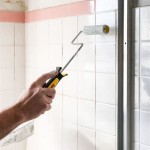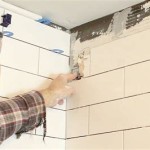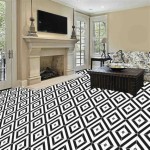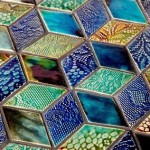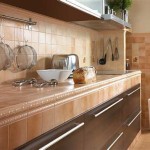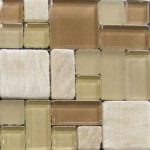Can You Put Tile On Drywall? A Comprehensive Guide
The question of whether tile can be installed directly onto drywall is a common one for homeowners and contractors alike. While technically feasible under certain circumstances, the suitability of drywall as a substrate for tile depends on various factors. This article delves into the intricacies of installing tile on drywall, exploring the requirements, potential problems, and recommended alternatives. Understanding these aspects is crucial for achieving a durable and aesthetically pleasing tiled surface.
Drywall, also known as gypsum board, is a widely used building material known for its ease of installation and cost-effectiveness. It consists of a gypsum core sandwiched between two layers of paper facing. Though it provides a suitable surface for paint and wallpaper, its inherent properties may not make it ideal for supporting the weight and moisture exposure associated with tile installations. The porous nature of drywall, coupled with its relatively low strength when wet, raises concerns about its ability to adequately bond with tile adhesives and resist moisture damage over time.
Understanding the Limitations of Drywall as a Tile Substrate
One of the primary limitations of using drywall as a tile substrate is its lack of rigidity and moisture resistance. When subjected to moisture, drywall can soften and lose its structural integrity. This can lead to tile debonding, cracking grout, and ultimately, tile failure. The weight of the tile itself, combined with the daily wear and tear of a tiled surface, can also strain drywall, particularly in high-traffic areas. Additionally, drywall's propensity to absorb moisture can create a breeding ground for mold and mildew, further compromising the integrity of the installation and potentially posing health risks.
Another significant consideration is the type of tile being used. Small, lightweight tiles are less likely to cause problems compared to larger, heavier tiles. The weight of the tile directly impacts the stress placed on the drywall. Larger format tiles, such as those exceeding 12 inches in width or length, require a more robust substrate than drywall to ensure long-term stability. Similarly, natural stone tiles, which are often heavier and less uniform than ceramic or porcelain tiles, demand a firmer base.
The location of the tile installation also plays a crucial role. In areas with high moisture exposure, such as bathrooms and kitchens, the use of drywall as a tile substrate is particularly risky. Shower walls, backsplashes near sinks, and floors in humid environments are all prone to water damage. In these areas, moisture-resistant drywall or alternative substrates are strongly recommended to prevent water penetration and maintain the longevity of the tile installation.
The type of adhesive used is also a critical factor. While some tile adhesives are specifically formulated for use on drywall, they often come with limitations and may not be suitable for all types of tile or applications. It is essential to carefully review the adhesive manufacturer's instructions and ensure that the product is compatible with both the tile and the drywall. Failure to use the correct adhesive can result in poor adhesion and premature tile failure.
Key Factors Determining Drywall Suitability
Despite the inherent limitations of drywall, there are situations where it can be used as a tile substrate, provided certain precautions are taken. The condition of the drywall itself is paramount. The drywall must be in good condition, free from any signs of damage, such as cracks, dents, or water stains. Repairing any existing damage before tiling is essential to ensure a stable and reliable base. Any loose or delaminated drywall should be replaced entirely.
The type of drywall used also matters. Regular drywall is generally not recommended for tile installations, especially in areas prone to moisture. Moisture-resistant drywall, often referred to as "green board" or "blue board," is more suitable as it contains additives that make it less susceptible to water damage. However, even moisture-resistant drywall is not waterproof and should not be considered a substitute for a proper waterproofing membrane in shower areas or other high-moisture environments. Cement board is almost always the better option.
Proper preparation of the drywall surface is crucial for achieving a strong bond with the tile adhesive. This typically involves cleaning the surface to remove any dust, dirt, or grease that may interfere with adhesion. Priming the drywall with a suitable primer can also improve adhesion and prevent the drywall from absorbing moisture from the adhesive. The primer should be compatible with both the drywall and the adhesive, and it should be applied according to the manufacturer's instructions.
Reinforcing the drywall can also enhance its suitability as a tile substrate. This can be achieved by adding extra screws or nails to secure the drywall to the studs, or by applying a reinforcing mesh to the surface. These measures help to increase the rigidity of the drywall and reduce the risk of movement or cracking. However, reinforcement alone is not a substitute for using a more robust substrate, such as cement board, in demanding applications.
Finally, the expertise of the installer is a critical factor. A skilled installer will be able to assess the suitability of the drywall, prepare the surface properly, select the appropriate adhesive, and install the tile in a manner that minimizes the risk of failure. They will also be able to identify potential problems and recommend appropriate solutions. Hiring a qualified professional is essential for ensuring a successful and long-lasting tile installation.
Alternatives to Drywall for Tile Installations
In many cases, particularly in bathrooms, kitchens, and other high-moisture areas, alternative substrates are superior to drywall for tile installations. Cement board, such as Durock or Wonderboard, is a common and highly recommended choice. Cement board is a water-resistant and extremely durable material that provides a solid and stable base for tile. It is specifically designed to withstand the rigors of wet environments and can support the weight of even heavy tiles.
Another alternative is waterproof membrane systems. These systems involve applying a waterproof membrane directly to the studs or existing drywall. The membrane creates a barrier that prevents water from penetrating the wall cavity, providing excellent protection against moisture damage. Various types of waterproof membranes are available, including liquid-applied membranes, sheet membranes, and self-adhesive membranes. Each type has its own advantages and disadvantages, and the choice depends on the specific application and the installer's preferences.
Specialized tile backer boards are also available. These boards are designed specifically for tile installations and offer a combination of water resistance, strength, and ease of installation. They are typically made from a composite material that is lightweight yet durable, making them a good option for both walls and floors. Some tile backer boards also feature a textured surface that enhances adhesion with tile adhesives.
When choosing an alternative substrate, it is important to consider the specific requirements of the project. Factors such as the size and weight of the tile, the level of moisture exposure, and the structural integrity of the existing wall or floor should all be taken into account. Consulting with a qualified tile contractor or building professional can help you select the best substrate for your needs.
Proper installation of the alternative substrate is just as important as choosing the right material. The substrate should be installed according to the manufacturer's instructions, ensuring that it is securely fastened to the studs or framing. Seams and joints should be properly sealed to prevent water penetration. A level and plumb surface is essential for achieving a professional-looking tile installation.
In conclusion, while technically possible in certain limited circumstances, installing tile directly on drywall is generally not recommended, especially in moisture-prone areas. The limitations of drywall as a substrate, including its lack of rigidity and moisture resistance, can lead to tile failure and water damage. Choosing a more robust and water-resistant substrate, such as cement board or a waterproof membrane, is essential for ensuring a durable and long-lasting tile installation. Proper installation and surface preparation are also critical for achieving optimal results. Consulting with a qualified professional is highly recommended to determine the best approach for your specific project.

Can You Tile Over Drywall Maine

Can You Tile Over Drywall Maine

How To Tile Over Sheetrock Doityourself Com

Tile Over Drywall Showers A Common But Bad Practice Scott Hall Remodeling

Everything About Installing Tiles On Drywall

Everything About Installing Tiles On Drywall

How To Install Tile Backsplash Fixthisbuildthat

Everything About Installing Tiles On Drywall

Can You Tile Over Drywall Is It Safe Home Efficiency Guide

Unslightly Transition From Tile To Drywall Need Advice
Related Posts

